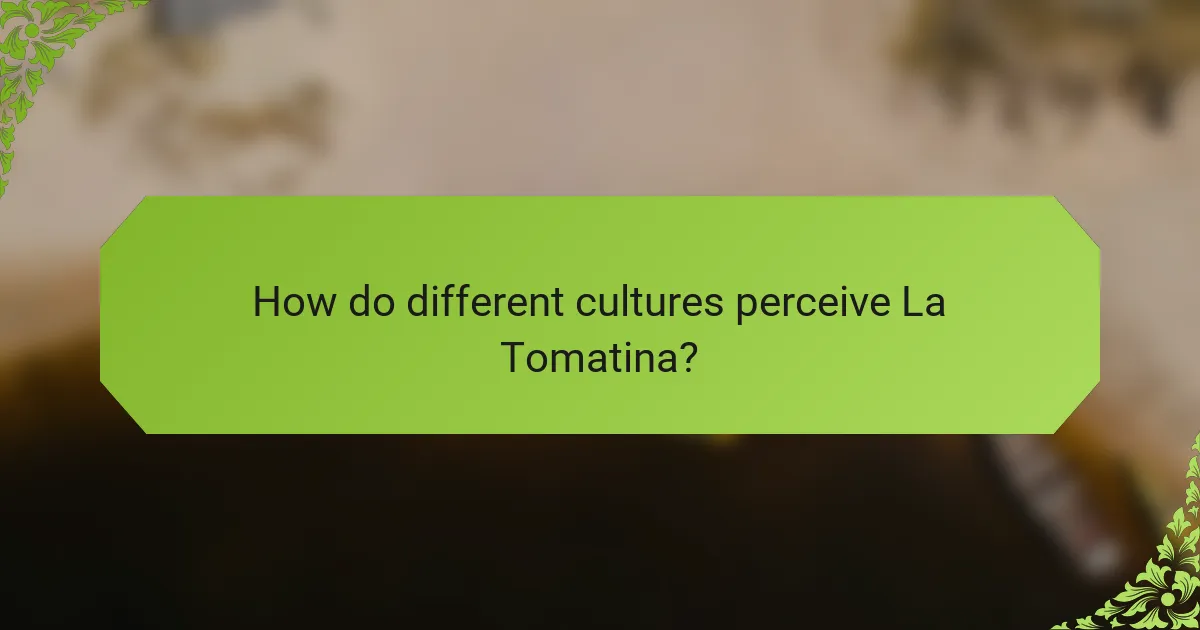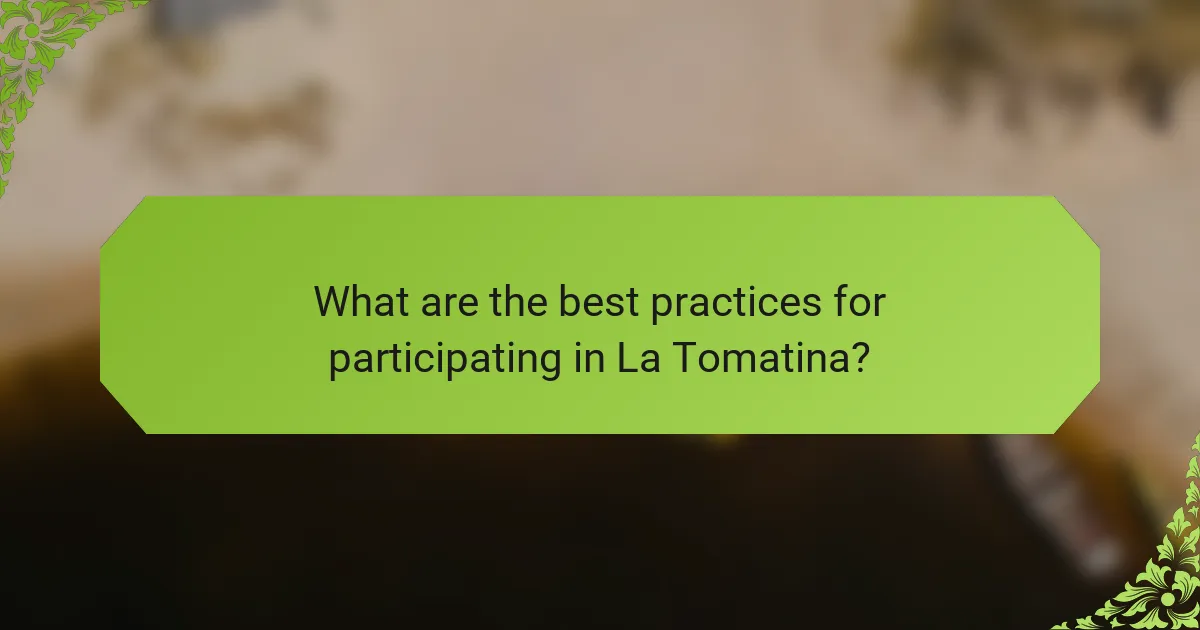La Tomatina is a vibrant festival in Buñol, Spain, where participants engage in a massive tomato fight. This article explores the event’s origins, its cultural impact on local and global communities, and practical tips for participation. The festival fosters community spirit and highlights Spain’s rich tradition of celebration, while also facing challenges related to sustainability and safety. Understanding these aspects enhances appreciation for this unique cultural phenomenon.

What are the origins of La Tomatina and its significance in Spanish culture?
La Tomatina originated in 1945 during a local festival in Buñol, Spain, when participants began throwing tomatoes at each other. This event has evolved into a globally recognized festival, symbolizing community spirit and playful chaos in Spanish culture. The significance lies in its ability to unite people through joy and laughter, creating a unique cultural identity. Each year, thousands gather to partake in this vibrant celebration, highlighting Spain’s penchant for festivity and tradition.
How did La Tomatina evolve from a local tradition to an international phenomenon?
La Tomatina evolved from a local tradition into an international phenomenon due to its unique appeal and media coverage. Initially a small, playful food fight in Buñol, Spain, it gained popularity in the 1980s as tourists began to participate. Social media further amplified its reach, attracting thousands of visitors annually. The event’s vibrant atmosphere and communal spirit resonate globally, making it a symbol of joy and cultural celebration. As a result, La Tomatina has become a must-see event for travelers seeking unique experiences.
What role does the town of Buñol play in the event’s identity?
Buñol is integral to La Tomatina’s identity as it hosts the event, shaping its cultural significance. The town’s rich history and community involvement elevate the festival, attracting thousands annually. Local traditions and the spirit of camaraderie define the experience, making Buñol synonymous with this unique celebration. The town’s infrastructure supports logistics, ensuring participants enjoy a safe and memorable event.

How is La Tomatina celebrated and what are its key activities?
La Tomatina is celebrated through a massive tomato fight in Buñol, Spain, attracting thousands of participants. Key activities include the gathering of participants, the throwing of ripe tomatoes, and the festive atmosphere created by music and dancing. The event fosters community spirit and cultural exchange, making it a significant attraction for locals and tourists alike.
What are the main rules and guidelines participants must follow during the event?
Participants in La Tomatina must follow specific rules to ensure safety and enjoyment. Key guidelines include wearing old clothes, as the event can be messy, and avoiding hard objects. Participants should also respect others and maintain a friendly atmosphere. Additionally, it is crucial to stay hydrated and follow instructions from event organizers for safety.
Which types of tomatoes are used and why are they significant?
The types of tomatoes used in La Tomatina are primarily overripe, low-quality varieties. These tomatoes are significant because they are inexpensive and not suitable for consumption, allowing participants to engage in the event without wasting food. Using these tomatoes emphasizes the festival’s playful spirit and environmental awareness.

What cultural impacts has La Tomatina had on local and global scales?
La Tomatina has significantly influenced both local culture and global perceptions of Spanish festivals. Locally, it fosters community spirit and tourism, enhancing the cultural identity of Buñol. Globally, it symbolizes playful rebellion and attracts international visitors, promoting cultural exchange and awareness. The event showcases the unique attribute of food-based festivities, emphasizing joy and participation over competition. As a result, La Tomatina has become a cultural phenomenon, inspiring similar events worldwide.
How does La Tomatina influence tourism and local economy in Buñol?
La Tomatina significantly boosts tourism and enhances the local economy in Buñol. This annual event attracts thousands of visitors, creating demand for local accommodations, restaurants, and services.
The festival generates substantial revenue through ticket sales, merchandise, and food vendors. In 2022, an estimated 20,000 participants contributed over 1 million euros to the local economy.
Additionally, La Tomatina promotes cultural exchange and global awareness of Buñol, enhancing its reputation as a tourist destination. The influx of tourists during the festival creates job opportunities and supports local businesses year-round.
As a result, this unique event not only fosters community pride but also sustains economic growth in the region.
What are the environmental concerns associated with the event?
La Tomatina raises several environmental concerns, primarily related to waste and water usage. The event generates significant food waste, as thousands of tomatoes are thrown and left on the streets. This waste can lead to pollution and attract pests. Additionally, the large volume of water used to clean up afterward strains local resources. The event’s impact on local ecosystems, particularly in terms of soil and water quality, is an area of growing concern.

How do different cultures perceive La Tomatina?
Different cultures perceive La Tomatina as a unique celebration of joy and community engagement. In Spain, it symbolizes tradition and local pride, while other cultures view it as a curious spectacle of chaos and fun. For instance, tourists often participate for the novelty, contrasting with locals who see it as an annual rite. Furthermore, the event has inspired similar tomato-throwing festivals worldwide, showcasing its cultural impact beyond Spain. Overall, La Tomatina reflects diverse interpretations, from cultural heritage to global entertainment.
What variations of tomato-throwing festivals exist around the world?
Various tomato-throwing festivals exist globally, each with unique traditions and cultural significance. La Tomatina in Spain is the most famous, attracting thousands to throw ripe tomatoes in a spirited celebration. Other notable festivals include the Tomatina de Buñol, which inspired similar events in locations like the Philippines and Italy. The world’s variations highlight local customs, such as the Sagra del Pomodoro in Italy, which combines tomato throwing with culinary festivities. Each festival reinforces community bonds and showcases regional pride through the shared joy of this playful activity.
How do participants from different countries engage with La Tomatina?
Participants from different countries engage with La Tomatina through various cultural expressions and traditions. Many international attendees travel to Spain to experience the unique festival, embracing its playful spirit. Tourists often participate in organized tours, enhancing their understanding of local customs. Some countries have similar tomato-throwing events, fostering a sense of global community. The event attracts diverse groups, showcasing its broad cultural impact.

What are the challenges and controversies surrounding La Tomatina?
La Tomatina faces challenges such as environmental concerns, safety issues, and cultural controversies. The event generates significant waste, leading to debates about its sustainability. Safety is a concern due to potential injuries from slipping or being hit by tomatoes. Additionally, some question the cultural significance of the festival, arguing it may overshadow traditional practices. These factors contribute to ongoing discussions about the future of La Tomatina.
What safety measures are implemented to protect participants?
La Tomatina implements various safety measures to protect participants during the event. These include designated areas for throwing tomatoes, medical teams on-site, and strict crowd control protocols. Participants are encouraged to wear protective eyewear and avoid bringing hard objects to enhance safety. Additionally, organizers limit the number of attendees to prevent overcrowding, ensuring a manageable and secure environment.
How has the event been critiqued in terms of waste and sustainability?
La Tomatina has faced significant critique regarding its waste and sustainability practices. Critics highlight the massive amounts of tomatoes discarded during the event, which raises concerns about food waste and environmental impact. The festival generates substantial waste, including packaging and leftover produce, prompting discussions about more sustainable practices. Some suggestions include composting the tomatoes and reducing plastic use. The unique attribute of La Tomatina is its cultural significance, which complicates sustainability efforts as many participants prioritize tradition over environmental concerns.

What are the best practices for participating in La Tomatina?
To participate in La Tomatina effectively, follow these best practices: wear old clothes, bring protective eyewear, and stay hydrated. Arrive early to secure a good spot and familiarize yourself with the area. Respect others and the environment; avoid throwing anything other than tomatoes. Lastly, enjoy the experience and embrace the fun atmosphere.
What should first-time participants know before attending the event?
First-time participants should prepare for a unique experience at La Tomatina. Understanding the event’s rules and cultural significance enhances participation.
1. Wear old clothes; they will get stained and damaged.
2. Arrive early to secure a good spot for the festivities.
3. Stay hydrated throughout the day to maintain energy.
4. Respect local customs and fellow participants for a positive atmosphere.
5. Follow safety guidelines to avoid injuries during the tomato fight.
6. Be ready for a fun, messy experience that celebrates community and joy.
How can participants ensure a fun and safe experience during La Tomatina?
Participants can ensure a fun and safe experience during La Tomatina by following essential guidelines. First, wear old clothes that can be discarded afterward, as the tomato pulp can stain. Stay hydrated before and during the event to maintain energy levels. It’s crucial to respect others; avoid aggressive behavior and keep the atmosphere light-hearted. Participants should also be aware of their surroundings and avoid crowded areas to prevent accidents. Lastly, follow local regulations and instructions from event organizers to contribute to a safe environment.



